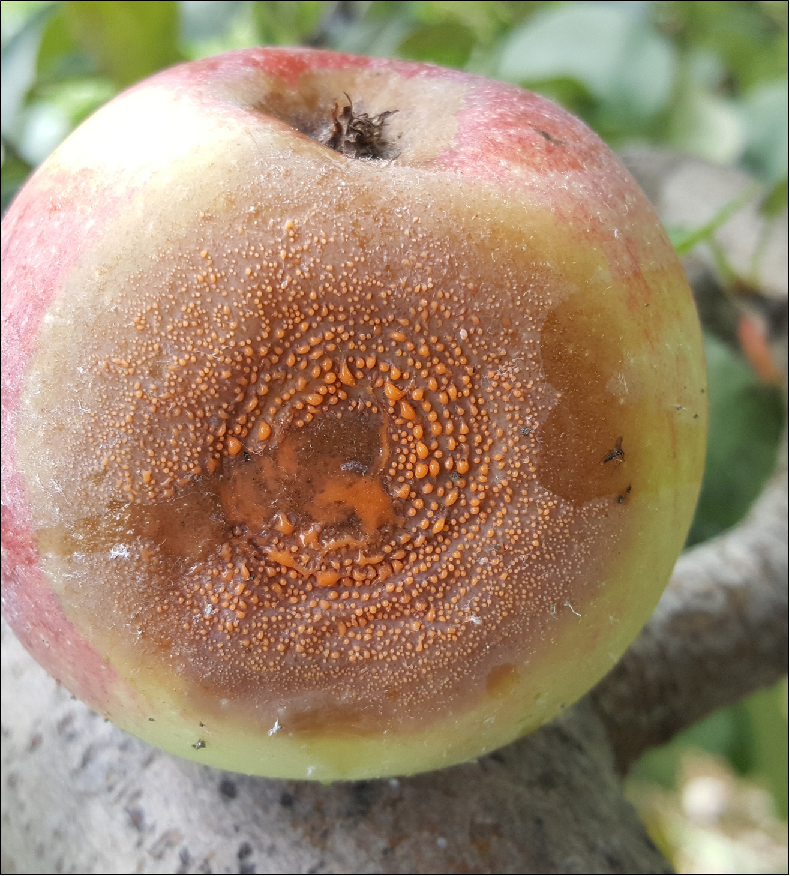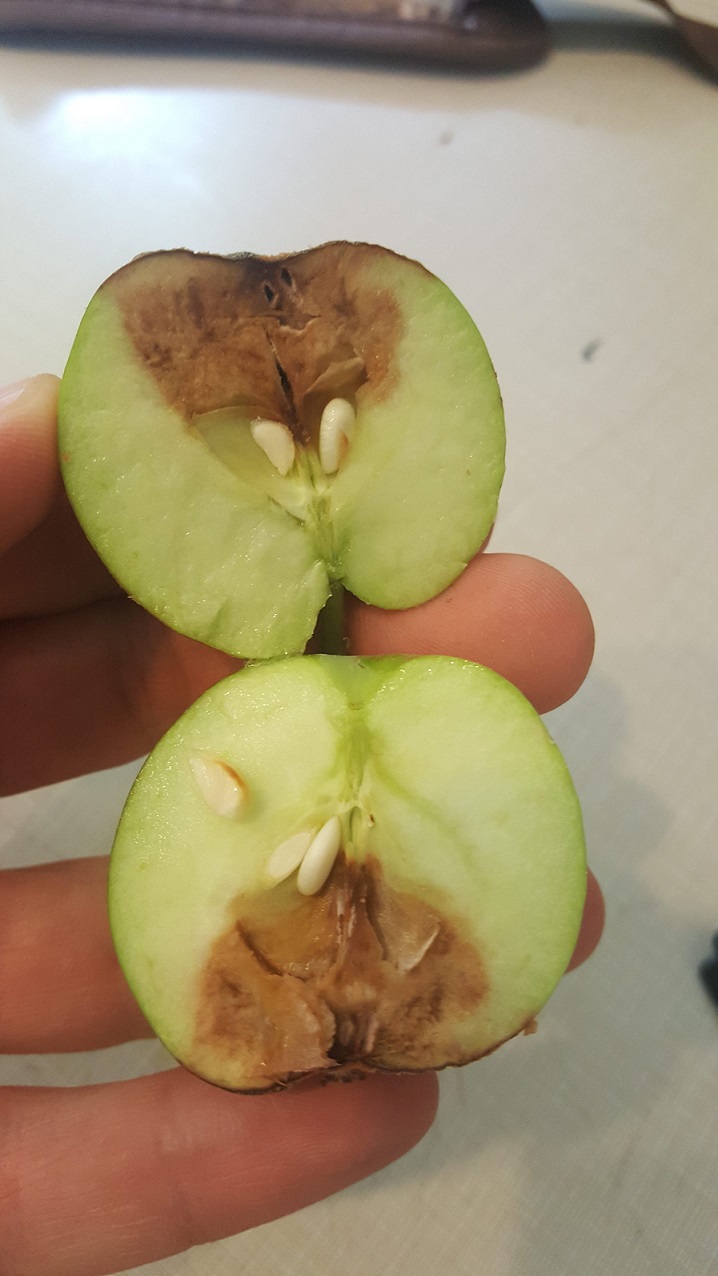1. Apple Bitter Rot Pressure Builds Up Late May to Early June in Virginia with Warm Wetting Events; 2. Fungicide Timing Dictated by Critical Rain Events
By Dr. Srdjan Acimovic & Dr. Fatemeh Khodadadi
Apple bitter rot disease was a widely present problem in apple orchards in 2021. This disease is caused by different fungi from Colletotrichum genus and is favored by warm, wet and humid weather conditions during late spring and the whole summer. The infection pressure starts to build up in early June in Virginia. The infections on fruit usually occur when fungicide cover sprays are too far apart while rains are more frequent and spray applications do not follow these rain events. Even more complicating is extending a spray interval while delivering fungicides in an alternate row middle spray schedule. This opens significant gaps in coverage allowing bitter to infect. The frequent rains we had in the last 10 days in Virginia (Fig-s 1, 2, and 3) were favoring early bitter rot pressure build up.
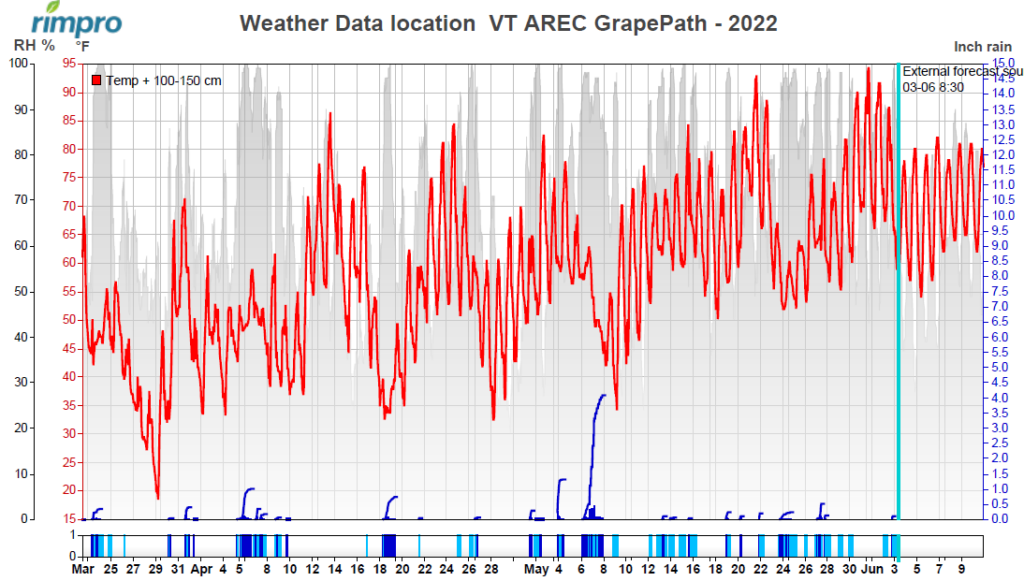
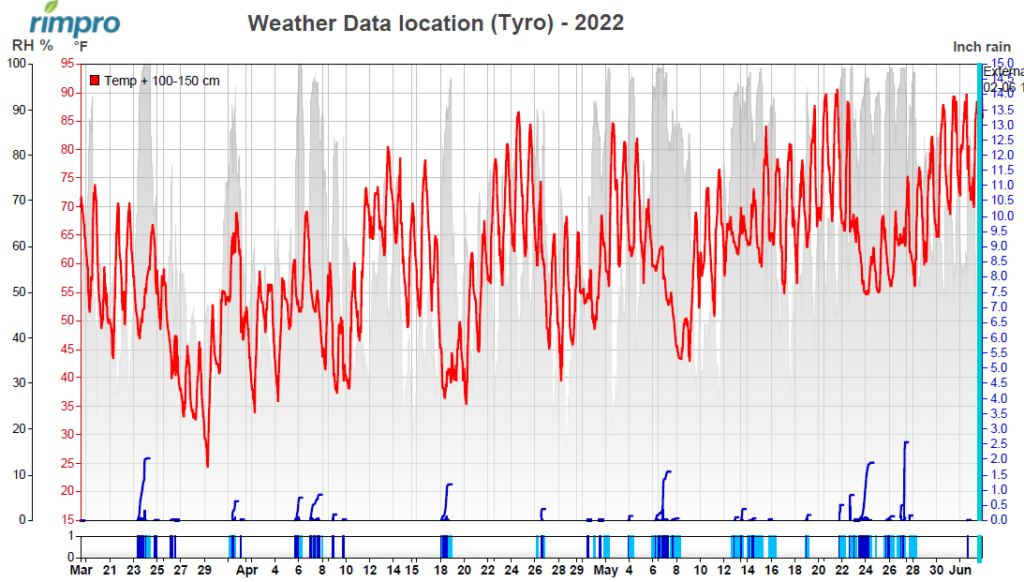
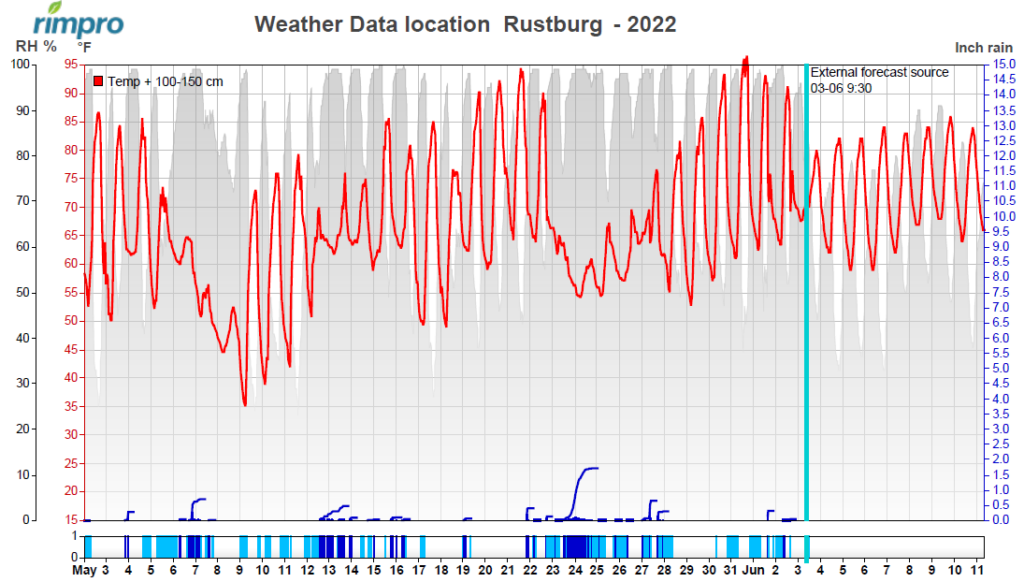
With such weather trends, as the apple fruit increases in size and continues to mature, you will need good protection with fungicides which should be selected and delivered according to the rain event frequency, not a fixed calendar spray schedule. One fungicide cover spray will be worth: 14 days or 2 inches of rain, whichever comes first, but if by any chance no rain falls for 14 days, you can extend the spray interval to 21 days, provided that no rain occurs during the 7 additional days. If rain event occurs any time during the additional 7 days, then apply fungicide before that rain event.
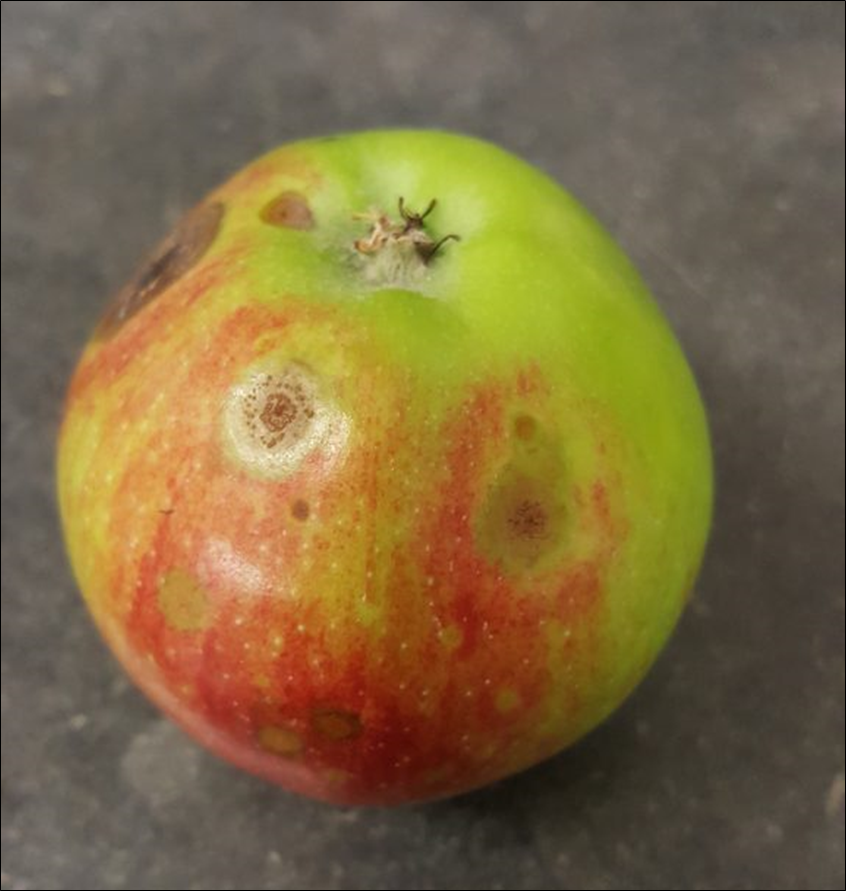
Infections on fruit unprotected by fungicides could appear in the first week of July, but if conditions in June or July are extremely conducive it is known to appear even earlier (Fig. 4). Occurrence of bitter rot is prevalent in orchard(s) but can spill over to a lesser degree into storage as a postharvest decay. Typical signs of apple bitter rot are very small light brown watery spots under the fruit skin that over time enlarge into 1/4 to an inch size rot lesions that are sunken like saucer in appearance (Fig. 5). In other words, the fruit loses its round shape, while other fruit rots (e.g. black or white rot) do not cause this flattening of the lesion (Fig. 5, 6). The V-shaped progress of bitter rot into apple flesh is a key telltale sign to discern bitter rot apart from other rots when infected fruit are cut open and lesions are 1 – 1/2 inch in size (Fig. 7).
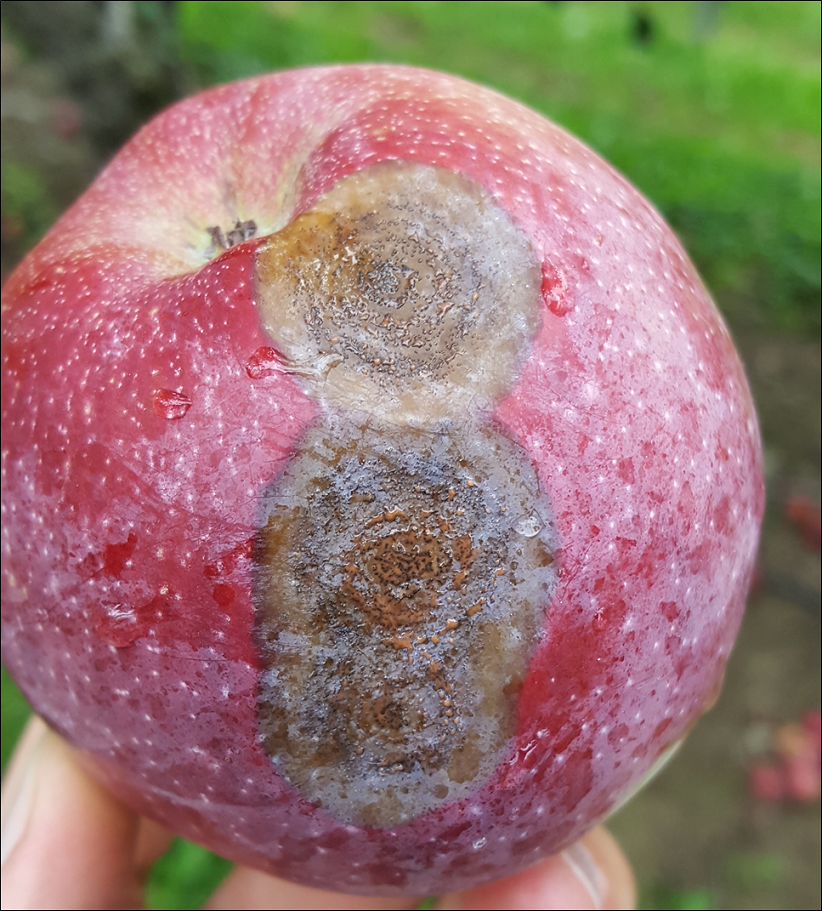
The best cultural practices to reduce inoculum pressure from this disease are removing fruit mummies left over on the trees which should be removed during dormant pruning. Decaying fruit on the orchard floor from last year should also be removed if possible or flail-mowed for faster degradation by soil microorganisms. Bitter rot fungi can also overwinter in fruit buds, but more research is needed to prove that in the growing conditions of Virginia. The most effective option for control of bitter rot are fungicides. Our trials led us to compile a list (see below) of summer cover spray combinations you could rotate, with no more than two consecutive applications of any of these combinations, with focusing in late spring on using weaker fungicides for bitter rot (e.g. Inspire Super; Prophyt, Topsin) or the ones that leave more visible residue, and going into more effective and less visible residue fungicides later. I list here fungicide combinations with the amounts per acre for 13 cover spray options, but your total cover number might be lower depending on your location, cultivar maturation, and number of rain events. Also the order of cover sprays can change as long as you rotate fungicides of different classes from cover to cover (group 7 or SDHI like Aprovia, with group 29 like Omega, with group 11 like Merivon, Luna Sensation, Pristine, and Flint Extra). Keep in mind that the first three cover sprays are designed to primarily control Sooty Blotch & Flyspeck when pressure from bitter rot is not yet high:
- 1C: Inspire Super* 12 fl oz/A + Captan 80 WDG 3 LB/A (or Ziram 6 lb)
- 2C: Topsin M 1 lb + Captan 80 WDG 3 lb (or Ziram 6 lb)
- 3C: Prophyt** 64 fl oz + Captan 80 WDG 3 lb (or Ziram 6 lb)
- 4C: Aprovia (30 PHI) + Captan 80 WDG 3 lb (or Ziram 6 lb)
- 5C: Aprovia (30 PHI) + Captan 80 WDG 3 lb (or Ziram 6 lb)
- 6C: Flint Extra 2.9 oz + Captan 80 WDG 3 lb (or Ziram 6 lb)
- 7C: Omega 500 (28 PHI) + Captan 80 WDG 3 lb (or Ziram 6 lb)
- 8C: Pristine 14.5 oz or Luna Sensation 5.8 fl oz + Captan 80 WDG 3 lb (or Ziram 6 lb)
- 9C: Omega 500 (28 PHI) + Captan 80 WDG 3 lb (or Ziram 6 lb)
- 10C: Captan 80 WDG 3 lb (or Ziram 6 lb)
- 11C: Merivon 5.5. fl oz + Captan 80 WDG 3 lb
- 12C: Captan 80 WDG 3 lb
- 13C: Merivon 5.5. fl oz + Captan 80 WDG 3 lb
*Under high disease pressure, DMI fungicides and are not effective for bitter rot control.
**Phosphites and thiophanate-methyl are not effective for bitter rot control.
Use the larger PHI period fungicides from mid-June and throughout July and August so you reserve your 0 days PHI Merivon for the last cover sprays.
Please limit group 11 fungicides only to 4 applications per season in total (four underlined fungicides above) to avoid development of fungicide resistance in Colletotrichum population species. This does not mean you can apply 4 applications of each of these materials: Flint Extra, Sovran, Luna Sensation, Pristine or Merivon. It is the opposite, since they all belong to the same group 11 fungicides which means that they have the same mode of action in the fungi, you can only use 4 applications of any of the fungicides in this group 11, per growing season. You can use either one group 11 active ingredient or choose different group 11 active ingredients just as long as their total number of applications does not exceed 4 in total per growing season (whichever is cheaper for your budget). My advice is to save Merivon or Pristine for your last, i.e. fourth group 11 fungicide application before harvest due to the zero days pre-harvest interval of these materials. Captan can be replaced with ziram and/or ferbam. Do not apply Ziram within 14 days of harvest and Ferbam is not recommended for late season cover sprays on fresh market fruit due to the potential for dark residual spots of Ferbam at harvest. Do not apply Ferbam within 7 days of harvest. Flint Extra, Aprovia, Omega, Inspire Super, Topsin M, Merivon, Flint, Pristine, Luna Sensation, Ziram and Ferbam are effective for control of sooty blotch and flyspeck as well.
